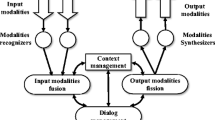Abstract
The SMIL 2.0 multimedia standard has been designed for use on the Web. It supports keyboard and mouse as input devices. Typically, SMIL players can play out text, images, audio, and video. SMIL also has a strong support for declarative synchronization and timing. Being an open standard, SMIL could well be utilized in custom applications, in environments such as info kiosks and multimedia consoles. However, these environments usually require better input and output capabilities not available in SMIL. This paper presents nine methods to extend SMIL for custom multimedia applications. The methods include ways to attach new input sources, output capabilities, and extended internal logic. Also, an implementation of an extensible SMIL player is given. As a conclusion, SMIL can be extended in several ways for custom multimedia applications. These extensions will provide new ideas for the future multimedia languages.
Similar content being viewed by others
References
M. Altheim et al., “Modularization of XHTML,” W3C Recommendation, April 10, 2001, http://www.w3.org/TR/xhtml-modularization/
Apple Computer Inc., “QuickTime and SMIL,” referenced August 14, 2003, http://developer.apple.com/techpubs/quicktime/qtdevdocs/IQ_InteractiveMovies/quicktimeandsmil/
J. Beckham, G. Di Fabbrizio, and N. Klarlund, “Towards SMIL as a Foundation for Multimodal, Multimedia Applications,” W3C Position Paper, October 1, 2001.
T. Bray et al., “Extensible markup language (XML) 1.0 (second edition),” W3C Recommendation, October 6, 2000.
T. Bray, D. Hollander, and A. Layman, “Namespaces in XML,” W3C Recommendation, January 14, 1999.
ECMA, “ECMAScript Language Specification 3rd Edition,” Standard ECMA-262, December 1999, ftp://ftp.ecma.ch/ecma-st/Ecma-262.pdf
S. Goose et al., “Streaming speech: A Framework for Generating and Streaming 3D Text-To-Speech and Audio Presentations to Wireless PDAs as Specified Using Extensions to SMIL,” in the Proc. of the Eleventh International World Wide Web Conference, Honolulu, Hawaii, USA, May 7–11, 2002.
R. Gordon and S. Talley, Essential JMF, Java Media Framework, Prentice Hall, 1998.
L. Hardman et al., “The link vs. the event: Activating and Deactivating Elements in Time-based Hypermedia,” Review of Hypermedia and Multimedia, Vol. 6, pp. 89–109, 2000.
M. Honkala and P. Vuorimaa, “XForms in X-Smiles,” WWW Journal, Vol. 4, No. 3, pp. 151–166, 2001.
M. Kim, S. Wood, and L. Cheok, “Extensible MPEG-4 textual format (XMT),” in the Proc. of the 2000 ACM workshops on Multimedia, LA, California, USA, pp. 71–74.
D. Newman et al., “XHTML+SMIL Profile,” W3C Note, January 31, 2002.
J. von Ossenbruggen et al., “Towards Second and Third Generation Web-based Multimedia,” in the Proc. of the Tenth International World Wide Web Conference, Hong Kong, China, May 1-5, 2001.
K. Pihkala and P. Vuorimaa, “Design of a Dynamic SMIL Player,” in the Proc. of the IEEE International Conference on Multimedia and Expo, Lausanne, Switzerland, August 26–29, 2002, pp. 189–192.
K. Pihkala, M. Honkala, and P. Vuorimaa, “A Browser Framework for Hybrid XML Documents,” in the Proc. of the 6th IASTED International Conference: Internet and Multimedia Systems, and Applications, Kauai, Hawaii, USA, August 12–14, 2002.
K. Pihkala, M. Honkala, and P. Vuorimaa, “Multimedia Web Forms,” in the Proc. of the SMIL Europe 2003 Conference, Paris, France, February 12–14, 2003.
RealNetworks Inc., “RealNetworks Production Guide,” referenced August 14, 2002, http://service.real.com/help/library/guides/realone/ProductionGuide/HTML/realpgd.htm
L. Rutledge, L. Hardman, and J. van Ossenbruggen, “Evaluating SMIL: Three User Case Studies,” in the Proc. of ACM Multimedia, Orlando, Florida, USA, November 1999.
L. Rutledge, J. van Ossenbruggen, and L. Hardman, “Anticipating SMIL 2.0: The Developing Cooperative Infrastructure for Multimedia on the Web,” in the Proc. of the Eighth International World Wide Web Conference, Toronto, Ontario, Canada, May 11–14, 1999.
L. Rutledge, “SMIL 2.0: XML for Web multimedia,” IEEE Internet Computing, Vol. 5, No. 5, pp. 78–84, 2002.
P. Schmitz, “Multimedia Meets Computer Graphics in SMIL 2.0: A Time Model for the Web,” in the Proc. of the Eleventh International World Wide Web Conference, Honolulu, Hawaii, USA, May 7–11, 2002.
P. Schmitz, “The SMIL 2.0 Timing and Synchronization Model: Using Time in Documents”, Technical Report MSR-TR-2001-01, Microsoft Corporation, Jan. 2001.
A. Vaha-Sipila, RFC 2806, “URLs for Telephone Calls,” April 2000.
J.Vierinen and P. Vuorimaa, “Dynamic Markup Language Based User Interfaces For A Browser”, in the Proc. of the IASTED International Conference on Communications, Internet & Information Technology, St. Thomas, Virgin Islands, USA, November 18–20, 2002, pp. 54–59.
P. Vuorimaa et al., “A Java based XML browser for consumer devices,” in the Proc. of the 17th ACM Symposium on Applied Computing, Madrid, Spain, March 10–13, 2002, pp. 1094–1099.
D. Žagar and S. Rimac-Drlje, “Applications classification and QoS requirements,” in the Proc. of the 24th International Conference on Information Technology Interfaces, Cavtat, Croatia, June 24–27, 2002, pp. 517–522.
Author information
Authors and Affiliations
Corresponding author
Additional information
Recently, W3C has published SMIL 2.1, which is an updated version of the SMIL 2.0 specification.
Kari Pihkala graduated from the Helsinki University of Technology, Finland, where he received his M.Sc. degree in 1999 and Ph.D. degree in 2004. His research interests include XML, multimedia, and mobile devices.
Petri Vuorimaa is head of the Telecommunications Software and Multimedia Laboratory, Helsinki University of Technology, Finland. He has both M.Sc. (1990) and Dr.Tech. (1995) degrees from Tampere University of Technology, Finland. His current research interests include digital television, mobile multimedia, and XML.
Rights and permissions
About this article
Cite this article
Pihkala, K., Vuorimaa, P. Nine methods to extend SMIL for multimedia applications. Multimed Tools Appl 28, 51–67 (2006). https://doi.org/10.1007/s11042-006-5120-y
Issue Date:
DOI: https://doi.org/10.1007/s11042-006-5120-y




